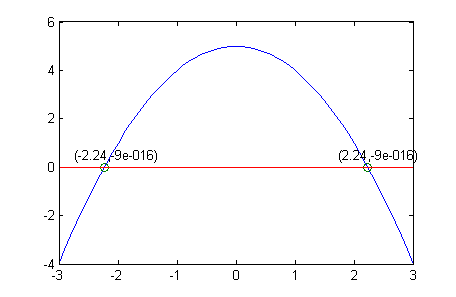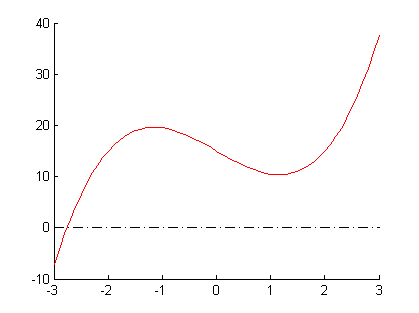Examples
Find the roots of the function

First, plot the function. The range -3 to 3 will show the roots we are interested in.

Place this code in a new m-file and run to see the plot shown here.
% Find and plot the roots of y=-x^2+5 from -3 to 3 % First, let's define an anonymous function to represent our function: fctn = @(x)-x.^2 + 5; % element-wise for vector use (when plotting) xx = -3:0.1:3; yy = fctn(xx); plot([-3 3],[0 0],'-.k', xx,yy,'r-')
Use
fzeroto find the roots of the function in Example 1. Place this code in the same m-file as you created for Example 1:% Find the roots of the function y=-x^2+5 and save them in vectors x and y x0 = [-2 2]; % initial guesses for the roots x(1) = fzero(fctn,x0(1)); % find the 1st root and save it in x y(1) = fctn(x(1)); % evaluate at that root x(2) = fzero(fctn,x0(2)); % find the 2nd root and save it in x y(2) = fctn(x(2)); % evaluate at that root % Plot the function and the roots hold on plot( [-3 3],[0 0],'-.k', xx,yy,'r-' ) % plot y=0 and the curve % Display each root and a label for it on the plot plot( x, y, 'bo' ) text( x(1)-0.5 , y(1)+0.5 , ... ['(' num2str(x(1),3) ',' num2str(y(1),1) ')' ]) text(x(2)-0.5 , y(2)+0.5 , ... ['(' num2str(x(2),3) ',' num2str(y(2),1) ')' ]) hold offHere is the figure that is produced, showing the curve and its roots.

Find the roots of the function
 A plot of the function is shown for your convenience.
A plot of the function is shown for your convenience.
This command will find the root near -3
>> fzero( @(x)3/2*x.^3-6*x+15, -3 );

